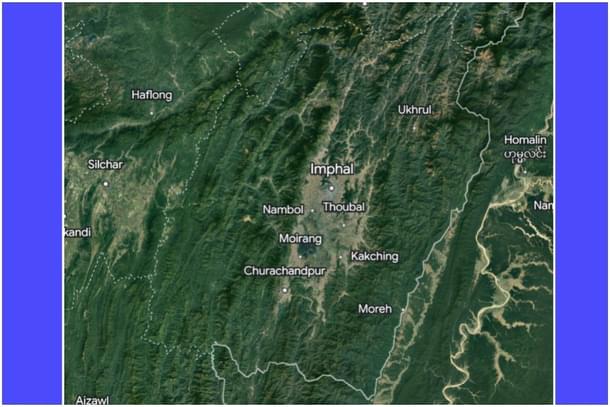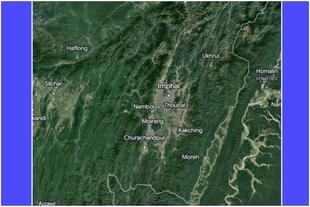Politics
Manipur Unrest: Contemporary Reasons Behind The Turmoil
Biman Das
May 06, 2023, 06:23 PM | Updated 06:23 PM IST
Save & read from anywhere!
Bookmark stories for easy access on any device or the Swarajya app.


The Northeastern state of Manipur may give off an aura of pristine beauty where rolling hills meet lush valleys, the diverse fauna arises from the dense flora to greet the various communities of the state but the eerie calm hides much deeper fault lines in its society.
The state is currently seeing violent ethnic clashes between the valley based-Meiteis and the hill-based Kuki tribes.
Both sides have been accusing the other of perpetrating horrific crimes in an attempt to evict the other community.
The Tribal Churches’ Leaders Forum having sided with the Kuki protestors by issuing a statement on solidarity compounded the tensions in the state further, leading many Hindu groups to suspect that these protests have some vested interests backing them.
Prior to these protests, there has been a history of the Kuki community having conflicts with other ethnic groups as well, such as the Nagas, Chakmas, Reangs and Assamese.
A notable example is the attack on the Tamils of Moreh by Kukis in June 1995 that led to large scale exodus of Tamils from the area (Nayar, p99).
Mizoram saw its significant Gorkha population dwindle on systematic pressure from the majority (Lisam).
Gorkhas that remain there today say that they are under increased stress to either assimilate into the local Mizo culture or leave the state.
Many have converted to Christianity and adopted Mizo names and customs overtime to be able to reside in the state (Singh).
The origins of the ongoing string of violence in the state can be traced to the previous Congress’ government’s excessive pandering to the tribal communities.
Following the formation of the Indian Republic, the central government passed the Constitution (Scheduled Tribes) Order, 1950 which gave Scheduled Tribe status to the Nagas and Kukis but not the Meiteis who shared cultural similarities with the Nagas.
This was followed by Manipur Land Reform and Land revenue Act 1960 which prohibited the purchase of tribal land by non-tribals in the state.
The Manipur Hill Areas District Councils Act 1971 subsequently gave increased powers to the Hill areas culminating with the Hill Areas Committee Order 1972 that put land under the jurisdiction of the Hill Areas Committee.
When these laws were enshrined into the state’s administration, the hills accounted for roughly 90 per cent of the state’s total area but merely a third of its population.
While the tribal population could purchase land throughout the entire state, the same liberty was not extended to the majority Meitei community who were restricted to the Imphal valley and the tiny Jiribam plains to the West.
The population pressure on the small valley has only gotten worse in the due course of time while the hill areas have been given a great deal of autonomy.
To give a better example, one can compare the population density of the neighbouring districts of Imphal West (998 per sq. km) to Tamenglong (32 per sq. km) and find it to be like contrasting densities of Bihar to Bhutan.
At present, Meitei groups insist that getting ST status is crucial to preserving the rights of their community. They believe that the population pressure caused by immigration from the hills to the valley would largely be nullified as Meiteis could then migrate to the sparsely populated hills themselves.
Meanwhile, the Naga and Kuki groups allege that doing so would put them at economic and cultural jeopardy since it would also permit Meiteis to purchase land in the hills. Furthermore, it would make it harder for them to compete against Meiteis if it comes to reservation benefits.
Perceived illegal immigration
Another perspective to the demographic dilemma in the state is the accusation of alleged illegal immigration to the hilly areas.
The hill districts of the state have seen abnormally high growth in their population leading many to accuse foul play to be occurring in the region.
Opponents argue that many of the local hillfolk are conniving with trespassers who are being allowed to settle into the hills of the state. Census data from the last few decades also show these regions to be recording growth rates far above that of even Bihar, a state infamously known for its high population growth.
Police officials have acknowledged that local chieftains are issuing forged documentation for Burmese migrants to legitimise their presence in the demographically sensitive state. Both Naga and Meitei groups such as the United Naga Council (UNC) and the Coordinating Committee on Manipur Integrity (COCOMI) have asked the Centre to look into the astronomical growth in the Kuki-dominated districts in the last few years (Matharu).
Kuki groups however rebuke such claims vehemently alleging them to be vested conspiracies against them. They assert that the demands by the Naga and Meitei groups for an NRC updation exercise akin to Assam’s are just a ruse to evict Kukis from their homelands to take over rumoured petroleum reserves (Yudhajit).
A closer look into the cumulative census records of the state show startling changes in demographic makeup of the state.
While the tribals made up roughly 31 per cent of the state’s total population against the Meiteis being 63 per cent in 1971, the makeup had shifted to 53 per cent for Meiteis against the tribals who had boomed to 41 per cent.
The bulk of this change however hasn’t been gradual but abrupt after insurgency arose in the state in the 90s. While the state averaged a population growth of 55 per cent from 1991-2011, the hill districts of Senapati and Chandel grew by 130 per cent and 108 per cent respectively.
Take the example of the Thadou tribe, which came up to 59,955 (5.59 per cent of total) in 1971 and had increased to 215,913 (7.56 per cent) by 2011.
To put it into a better perspective, Tangkhuls who were neck and neck at 57,851 (5.39 per cent) in 1971 grew to 178,586 (6.25 per cent).
Thadous have shown population growth far above the mean average of all the tribal communities in the state during the period.
Another community are the Mao Nagas who enumerated at 33,379 (3.11 per cent) and grew to 93,343 (3.26 per cent).
In addition to their original classification, Poumai Nagas, a subgroup under them were given a separate listing with their numbers - 127,381 (4.46 per cent) in 2011, bringing the sum to be a staggering 223,724 (7.83 per cent).
Notably Chief Minister Nongthombam Biren Singh has been fiercely opposed to the immigration of illegal migrants to the state. He has stated in the past that the state is willing to conduct a full scale NRC update throughout the state if the Centre were to give the green light.
He continued upon this by helping the passage of the Indian Forest (Manipur Amendment) Act, 2018 with the goal of evicting illegal settlers that have encroached forested belts. While the evictions in the Meitei and Pangal areas went peacefully, the same could not be said about the Kuki areas which have risen up accusing the state administration of perpetrating genocide on them.
The ongoing conflict has resulted in reportedly over 4,000 people being left homeless who have taken shelter in other parts of the state.
Meitei refugees are currently housed at military camps of the Indian army and paramilitary stationed in Churachandpur district.
The central government has deployed the Rapid Action Force of the Central Reserve Police Force in the affected areas of the state to prevent the condition of the state from worsening further. It is worth mentioning that the governor, Anusuiya Uikey has given the contingent the authority to shoot down any mischievous elements if they continue to persist even after incessant persuasions.
Naga Stand on the Issue
This issue is aggravated by inter-tribal rivalry between communities.
Nagas, particularly the Zelinagrongs frequently accuse the Kukis of encroaching on their lands and pushing them out. The 2016 protests in the state by Nagas could be seen as a result of the long held tension between Nagas and Kukis.
When Congress carved out the Thadou Kuki dominated Kangpokpi district from the largely Mao Naga Senapati district, Naga groups went up in arms as they felt the action legitimised the presence of perceived Kuki encroachments into their homelands.
The state would see the United Naga Council, a Naga pressure group, put a blockade on the crucially important Kohima-Imphal National Highway No 2 that brought in food and medicine supplies to the valley. The standstill continued for 50 days resulting in deep socio-economic losses to the state.
It may be emphasised that while the protests in Kuki areas have been violent in nature, the rallies held in Naga areas of the state have largely been peaceful.
In the aftermath of the violent clashes embroiling the southern part of Manipur, many Naga groups such as the Maram Union, Mao Union and Rongmei Naga Council Manipur have distanced themselves from the Indigenous Tribal Leaders’ Forum (ITL) which is spearheading the opposition towards the encroachment evictions in the tribal belts.
In addition to reiterating the territorial integrity of Manipur, the Rongmei Naga Council also advised tribal communities to refrain from taking part in rallies staged by the ITL.
Works Cited
Nayar, V. Low Intensity Conflicts in India. United Service Institution of India, 2008
Lisam, Khomdom. Who are the Indigenous People of Manipur ? - Part 3. EPAO, 2019
Singh, N. William. The Gorkhalis of Mizoram. HimalMag, 2012
Matharu, Sonal. ‘They’re taking over our hills’: Manipur groups want NRC to weed out Myanmar refugees. The Print, 2022.
Yudhajit, Shankar. Manipur violence: State is burning, but what is the decades-old fuel behind the fire. IndiaToday, 2023




